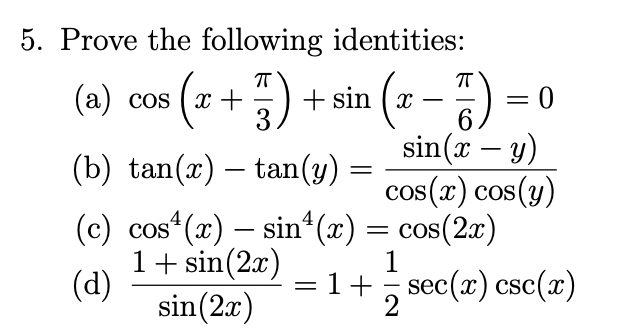5. Prove the following identities: (a) cos (x +) + sin (x = 0 6. sin(x – y) cos(x) cos(y) (c) cos*(x) – sin*(x) = cos(2x) cos ( x + 3 (b) tan(x) – tan(y) 4 1+ sin(2x) (d) sin(2r) 1 = 1+ sec(x) csc(x) 2
5. Prove the following identities: (a) cos (x +) + sin (x = 0 6. sin(x – y) cos(x) cos(y) (c) cos*(x) – sin*(x) = cos(2x) cos ( x + 3 (b) tan(x) – tan(y) 4 1+ sin(2x) (d) sin(2r) 1 = 1+ sec(x) csc(x) 2
Linear Algebra: A Modern Introduction
4th Edition
ISBN:9781285463247
Author:David Poole
Publisher:David Poole
Chapter7: Distance And Approximation
Section7.5: Applications
Problem 17EQ
Related questions
Question
100%

Transcribed Image Text:5. Prove the following identities:
(z - -) =
T
= 0
sin(x – y)
cos(x) cos(y)
(c) cos* (x) – sin“(x) = cos(2x)
(a) cos (x +
+ sin ( x
3
-
(b) tan(r) – tan(y)
1+ sin(2x)
(d)
sin(2x)
1
= 1+ sec(x) csc(x)
-
Expert Solution
This question has been solved!
Explore an expertly crafted, step-by-step solution for a thorough understanding of key concepts.
Step by step
Solved in 5 steps with 5 images

Recommended textbooks for you

Linear Algebra: A Modern Introduction
Algebra
ISBN:
9781285463247
Author:
David Poole
Publisher:
Cengage Learning

Linear Algebra: A Modern Introduction
Algebra
ISBN:
9781285463247
Author:
David Poole
Publisher:
Cengage Learning